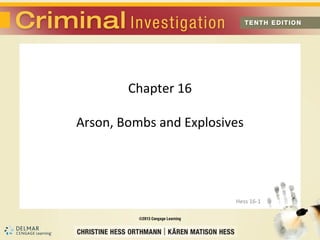
Chapter 16
- 1. Chapter 16 Arson, Bombs and Explosives Hess 16-1
- 2. Introduction • Arson, the malicious, willful burning of a building or property, is one of the oldest crimes known • Arson is difficult to prove • Police investigators partner with fire investigators to handle these crimes • Fire marshals, who also have law enforcement powers for fire-related incidents, investigate these crimes Hess 16-2
- 3. Classification of Fires CATEGORIES • Natural • Accidental • Incendiary (arson) • Undetermined origin Hess 16-3
- 4. Elements of the Crime: Arson ELEMENTS • Willful, malicious burning of a building or property • Of another or of one’s own to defraud • Causing to be burned, or aiding, counseling or procuring such burning Hess 16-4
- 5. Classification of Arson AGGRAVATED AND SIMPLE ARSON • Aggravated arson Intentionally destroying or damaging Fire or explosives or other infernal device Imminent danger to life or great bodily harm • Simple arson Intentional destruction by fire or explosives Does not create imminent danger to life Hess 16-5
- 6. Classification of Arson ATTEMPTED ARSON • Intent to set a fire • Some preparation to commit the crime SETTING NEGLIGENT FIRES • Causing a fire to burn • Causing a fire to get out of control Hess 16-6
- 7. Classification of Arson THE MODEL ARSON LAW • First degree: Burning of dwellings • Second degree: Burning of buildings other than dwellings • Third degree: Burning of other property • Fourth degree: Attempting to burn buildings or property Hess 16-7
- 8. The Arsonist JUVENILE FIRESETTING • Children are predominant victims • Fireplay versus firesetting MOTIVATION • Revenge most common motive • Insurance fraud Hess 16-8
- 9. Police and Fire Department Cooperation EXPERTISE • Fire department Detect arson Determine point of origin Probable cause • Police department Investigate arson Prepare the case for prosecution Hess 16-9
- 10. Other Sources of Assistance in Investigating Arson ADDITIONAL RESOURCES • Bureau of Alcohol, Tobacco, Firearms and Explosives • News media • Insurance companies • Arson task forces • Importance of the dispatcher Hess 16-10
- 11. Special Challenges in Investigation DIFFICULTIES • Coordinating efforts with fire department and others • Determining whether a crime has been committed • Finding physical evidence • Finding witnesses • Determining whether the victim is a suspect Hess 16-11
- 12. Responding to the Scene OBSERVATIONS • Presence of victims and witnesses • Vehicles leaving the scene • Flame and smoke conditions • Conditions surrounding the scene • Status of alarms and sprinklers Hess 16-12
- 13. The Preliminary Investigation OVERVIEW • Fire department usually receives the initial call • Fire personnel make out the report • Fire department establishes arson • Investigators must verify fire department findings • Understand distinctions for proving crime Hess 16-13
- 14. The Preliminary Investigation FIRE TRIANGLE • Arson will present an abnormal amount of Air Fuel Heat Hess 16-14
- 15. The Preliminary Investigation ARSON INDICATORS • Accelerants • Igniters • Burn indicators • Point of origin • Burning pattern • Appearance of collapsed walls and smoke color Hess 16-15
- 16. The Preliminary Investigation SUMMARY OF ARSON INDICATORS • Professionals use various igniters Magnesium rods, timed charge, acids PHOTOGRAPHING AND VIDEOTAPING AN ARSON FIRE • In-progress photographs • People at the fire scene Hess 16-16
- 17. The Preliminary Investigation PHYSICAL EVIDENCE • Very fragile • Identify accelerants (GF-FID) USING K-9s IN ARSON INVESTIGATIONS • Lab-certified accelerant-detection canine • Accelerants and suspects Hess 16-17
- 18. The Preliminary Investigation EVIDENCE ON SUSPECT, AT RESIDENCE OR IN VEHICLE • Unique odors • Insurance documents OBSERVING UNUSUAL CIRCUMSTANCES • Alterations to area • Providing more air, heat or fuel Hess 16-18
- 19. The Preliminary Investigation INTERVIEWING • Who had opportunity • Who benefits from it • Victim’s financial status • Cooperation level • First-in firefighters Hess 16-19
- 20. Search Warrants and Fire Investigations TYPES • Administrative Government agent needed to search the premises Determine the fire’s cause and origin • Criminal • Issued on probable cause • Premises yield evidence of a crime • Michigan v. Tyler (1978) Hess 16-20
- 21. Final Safety and Legal Considerations FINAL TIPS • Obtain consent or a warrant • Turn off utilities • Inspect and ventilate • Bring a partner • Wear proper safety gear • Avoid cross contamination Hess 16-21
- 22. Investigating Vehicle Arson DETERMINATIONS • Look for evidence of accelerants • Determine whether the vehicle was insured • Seldom arson if there was no insurance • Intent to defraud Hess 16-22
- 23. Prosecuting Arsonists DIFFICULTIES • 90 percent of arsonists go unpunished • Often committed without witnesses • Interagency cooperation required • Circumstantial evidence Hess 16-23
- 24. Preventing Arson KEY FACTORS • Abandoned properties • Negative-equity properties • Utilities were shut off • Prior-year fires • Gang locales • Drug hot spots Hess 16-24
- 25. Investigating Bombings and Explosions CLASSES • Juvenile/experimentation • Recovered military ordnance or commercial explosives • Emotionally disturbed persons • Criminal actions • Terrorist or extremist activity Hess 16-25
- 26. Responding to a Bomb Threat OVERVIEW • Nonchalant attitude could prove fatal • Do not touch the package • Using K-9s in detecting • Stationary technology Sniffer • Using robots Hess 16-26
- 27. Bomb Scene Investigation OVERVIEW • Special attention to fragments of device • Pay attention to powder at the scene • Determine motive • Determine scene parameters AWARENESS TRAINING AND TEAM APPROACH • Available training programs Hess 16-27
- 28. Summary • Fires are natural or accidental unless proven otherwise • Special challenges in investigating arson include coordinating efforts • Fire department is responsible for establishing whether arson has occurred • Law enforcement investigators must be able to verify such findings • When investigating vehicle fires, look for evidence of accelerants Hess 16-28
